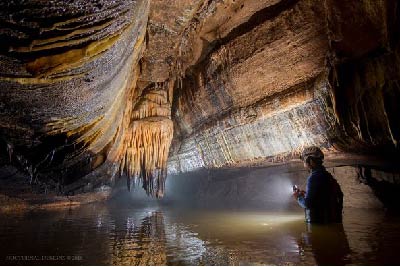 It’s easy for humankind to think they’ve seen it all. We’ve traveled to the moon, scaled the world’s highest peaks, and cataloged some of its wildest flora and fauna. And yet, so much of the world remains unexplored, so much unknown. Almost 95% of the oceans remain uncharted, and here in the Driftless Region, a hidden world lies beneath our feet.
It’s easy for humankind to think they’ve seen it all. We’ve traveled to the moon, scaled the world’s highest peaks, and cataloged some of its wildest flora and fauna. And yet, so much of the world remains unexplored, so much unknown. Almost 95% of the oceans remain uncharted, and here in the Driftless Region, a hidden world lies beneath our feet.
I’m talking, of course, about caves.
If you were to roll back time to the Precambrian era, you might be quite shocked to find out that you’d be underwater. During this time, the area now known as the Driftless was part of a tropical sea, a vastly different climate than what we live in today. For the next several hundreds of millions of years, sediment from the seafloor would gradually settle and compact. As a result, you can find an abundance of fossilized sea life from the Paleozoic to the Cenozoic era in the region’s bedrock.
This period of sedimentary creation also set the table for one of nature’s greatest artforms, as the continents and tectonic plates reshaped the earth into the landmass we recognize as North America. Glaciers came to dominate, but as many denizens of the Driftless know, they never reached this narrow corridor for a myriad of reasons. While the surface’s ecosystem was spared from being ground away by up to 10 million metric tons of ice, the glaciers still had a profound effect under the soil.
As the glaciers began to recede, massive amounts of meltwater created the bluffs and valleys that have become iconic to the Driftless area. However, not all of the runoff siphoned the mighty Mississippi. The region’s sedimentary foundation, weak to the mildly acidic erosion of water, developed fissures that grew into what are now known as sinkholes: large depressions in the ground where layers of limestone, dolomite, and all of beneath the soil has been eaten away. This is only the beginning of a delicate and painstakingly slow process.
 In the documentary, Decoding the Driftless, the filmmakers explain that sinkholes are just the first stop in a cycle that forms an expansive network of caves that lie beneath our feet. After carving its way through the early layers of sediment, the weakly acidic water continues to make its way down, carrying away particles of stone and minerals and leaving behind large underground spaces. The water eventually goes on to fuel the area’s innumerable springs and aquifers. It’s funny to consider the fact that the water coming out of your tap was very likely rain falling upon the rolling prairies and farmlands above the bluffs. It’s this same principle that has spurred such concern about groundwater contamination and how the land practices of a few can affect the quality of life for the greater region.
In the documentary, Decoding the Driftless, the filmmakers explain that sinkholes are just the first stop in a cycle that forms an expansive network of caves that lie beneath our feet. After carving its way through the early layers of sediment, the weakly acidic water continues to make its way down, carrying away particles of stone and minerals and leaving behind large underground spaces. The water eventually goes on to fuel the area’s innumerable springs and aquifers. It’s funny to consider the fact that the water coming out of your tap was very likely rain falling upon the rolling prairies and farmlands above the bluffs. It’s this same principle that has spurred such concern about groundwater contamination and how the land practices of a few can affect the quality of life for the greater region.
But alas, I digress. Since my childhood, I have always been fascinated by these naturally occurring works of art. School field trips to locations like Niagara Cave and Mystery Cave created a sort of nostalgic mystique that I have always associated with a degree of fantasy-made-real. There’s something inexplicably incredible about the miles and miles of underground tunnels that stretch beneath us, out of sight. A human spark of curiosity provokes me to want to know and experience more about these unseen wonders of the world, and that is exactly what I intend to do this spring. Destinations like Crystal Cave, Cave of the Mounds, and the Kickapoo Indian Caverns are all places within the Driftless area that I hope to visit and write more about. –Jonathon Howe

